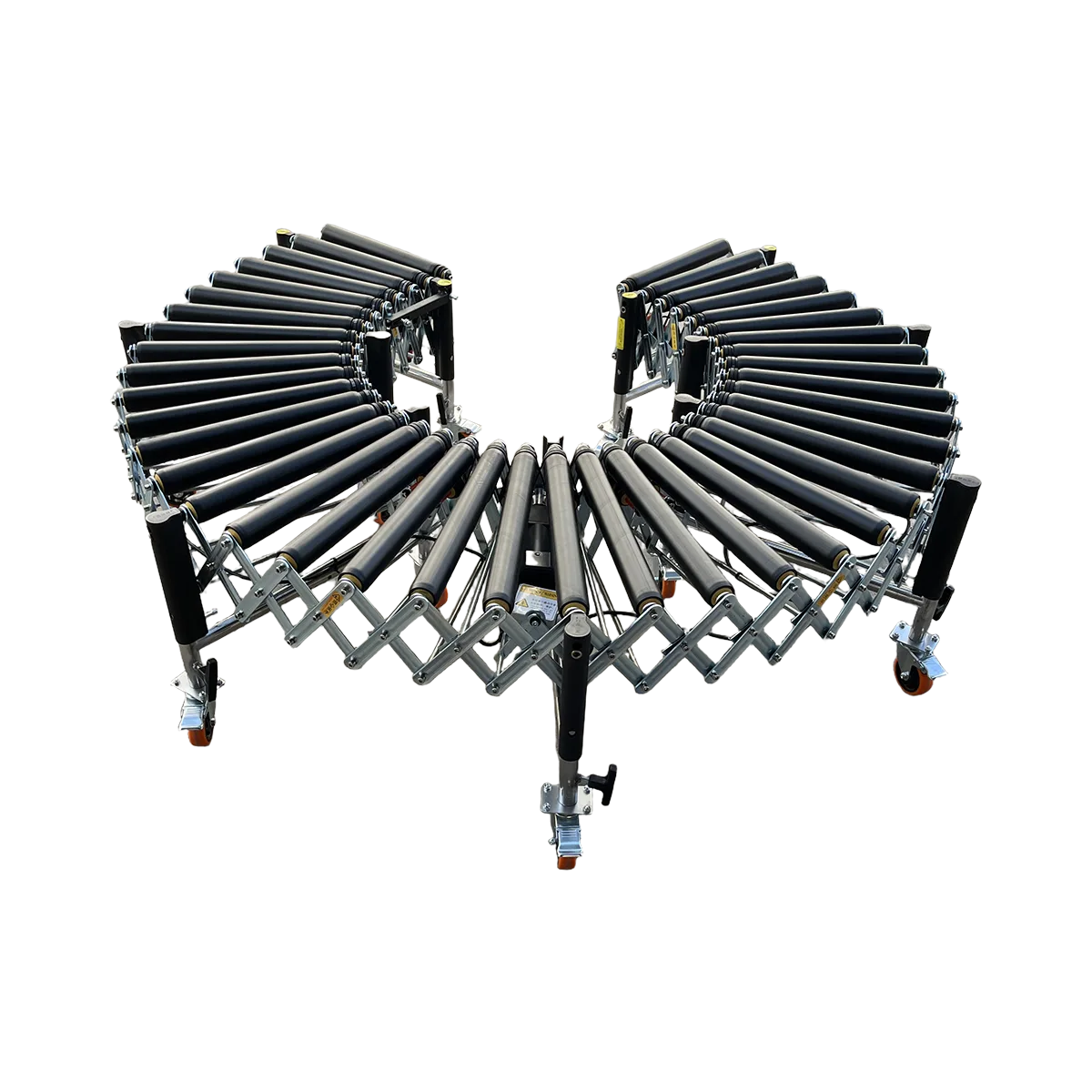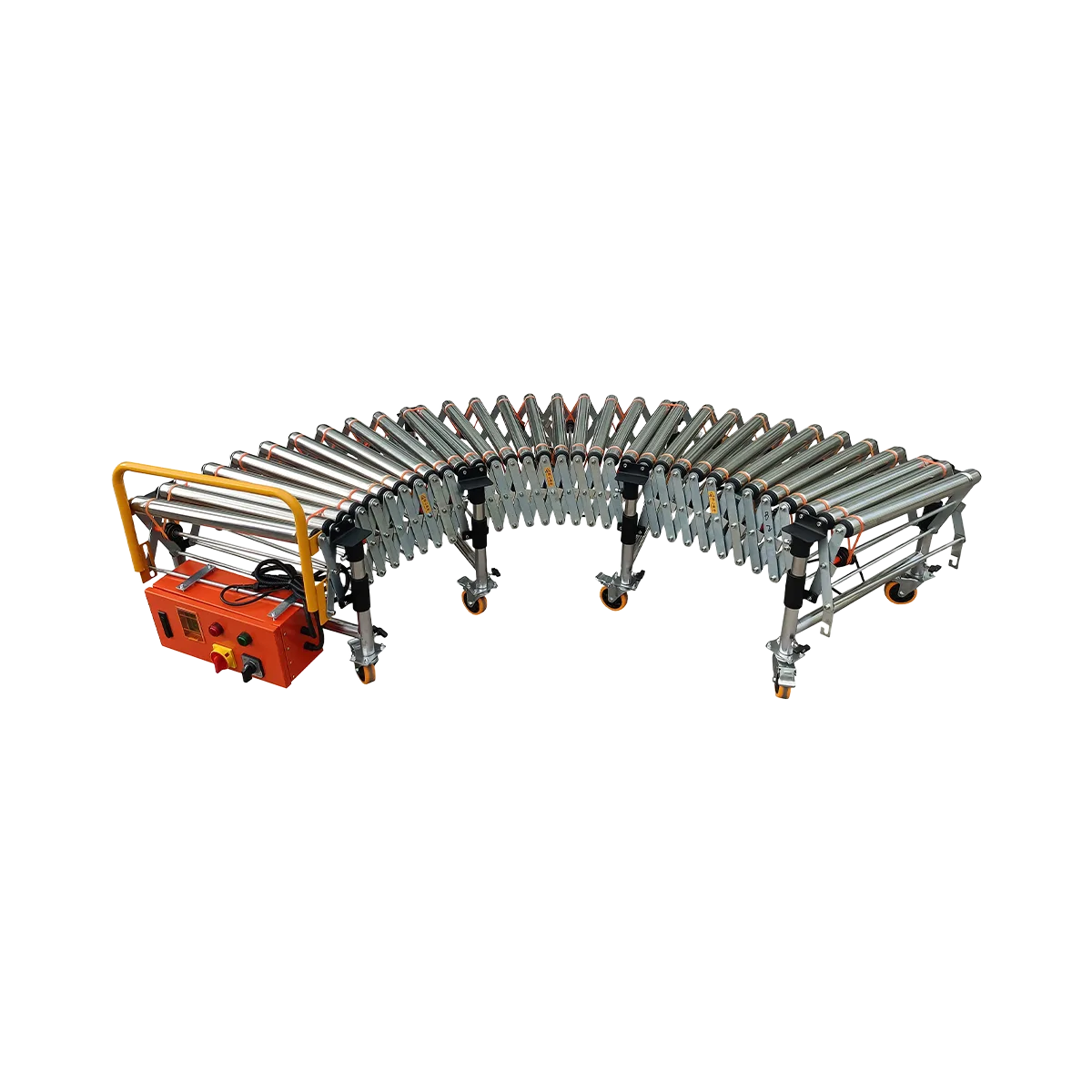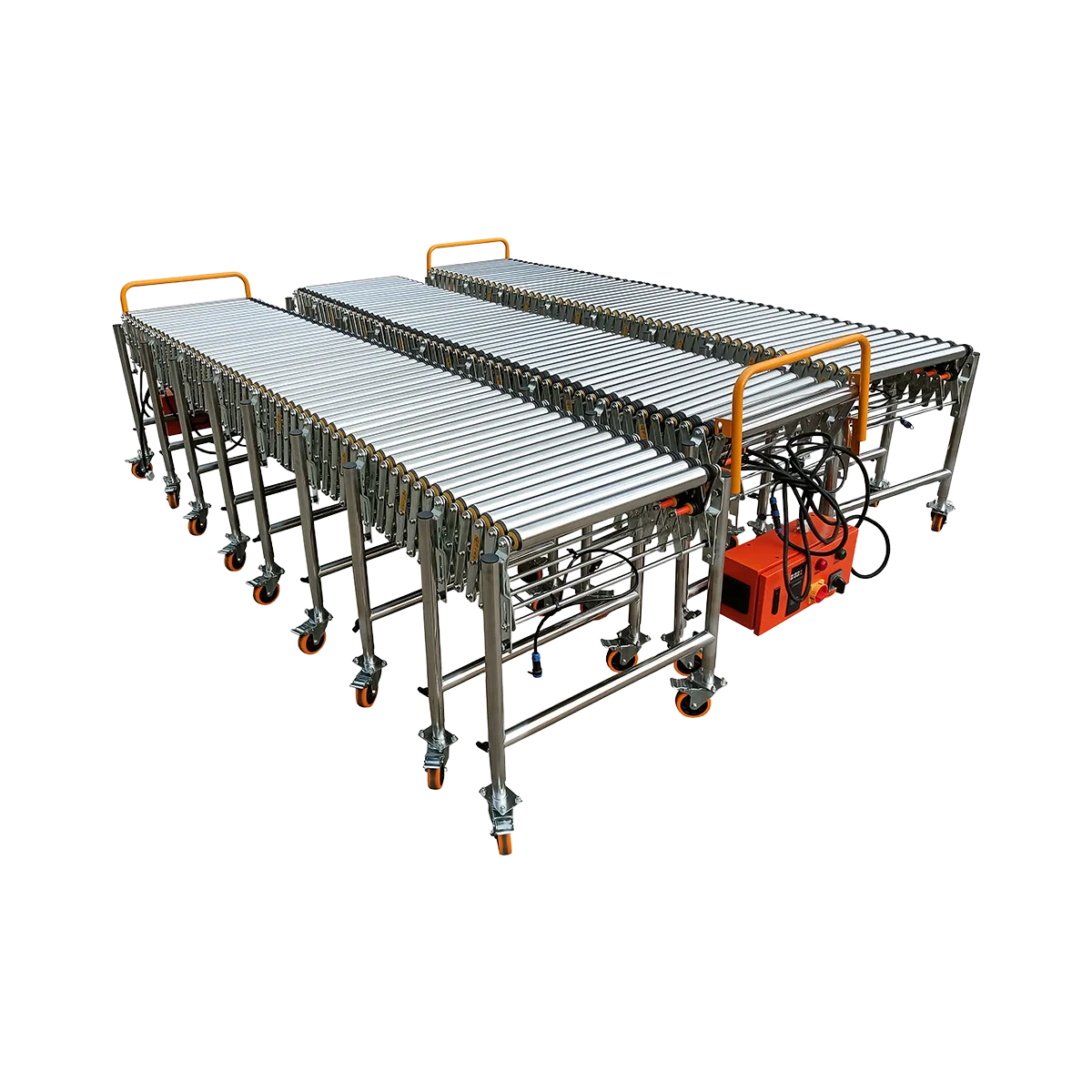Warehouse Transport System for an Auto Parts Distribution Center
Optimize your automotive logistics warehouse with a versatile auto parts conveyor system. Handle mixed-size boxes efficiently with our durable roller conveyor solutions.
Related Products
-
Powered Rubber Roller Conveyor – Multi-wedge Belt Driven – 1100 mm/SectionCollapsed Length
560 mm
Extended Length1100 mm
Load Capacity120 kg/m
Applicable GoodsFlat-bottomed Goods
Bagged Goods
-
Powered Roller Conveyor – O-shaped Belt Driven – 1500 mm/SectionCollapsed Length
525 mm
Extended Length1500 mm
Load Capacity80 kg/m
Applicable GoodsFlat-bottomed Goods
-
Powered Roller Conveyor – Multi-wedge Belt Driven – 2000 mm/SectionCollapsed Length
700 mm
Extended Length2000 mm
Load Capacity100 kg/m
Applicable GoodsFlat-bottomed Goods
-
Powered Roller Conveyor – Multi-wedge Belt Driven – 3000 mm/SectionCollapsed Length
1050 mm
Extended Length3000 mm
Load Capacity80 kg/m
Applicable GoodsFlat-bottomed Goods
Auto parts distribution centers face a unique challenge in material handling: managing thousands of different components that vary dramatically in size, weight, and packaging. From tiny O-rings in small boxes to heavy brake rotors in dense packaging, an effective auto parts conveyor system must handle this diversity without compromising efficiency or durability. Implementing the right warehouse transport system can transform operations, reducing labor costs while increasing throughput in these busy automotive logistics warehouse environments.
The Need for Versatility in Auto Parts Handling
The automotive aftermarket is characterized by extreme product diversity:
- Size variation: Parts range from tiny electronic components to large body panels
- Weight differences: From lightweight filters (under 1kg) to engine blocks (over 50kg)
- Packaging types: Plastic bags, cardboard boxes, metal containers, and custom packaging
- Handling requirements: Some parts require careful handling, while others are robust
- Urgency levels: Different priority levels from standard to emergency overnight shipping
This diversity creates significant challenges for warehouse operations. Traditional conveyor systems often struggle with this variability, requiring separate handling processes for different part categories. This fragmentation leads to inefficiency, higher labor costs, and increased error rates.
A typical auto parts distribution center processes thousands of SKUs daily, with orders ranging from single emergency components to large wholesale restocking shipments. Any conveyor solution must accommodate this full spectrum of items while maintaining consistent throughput rates.
Common Challenges in Auto Parts Distribution
| Challenge | Impact | Solution Requirement |
|---|---|---|
| Mixed package sizes | Inefficient sorting and handling | Adjustable width and flexible handling |
| Variable weights | Strain on equipment and workers | High load capacity (80-100kg/m) |
| Fluctuating volume | Bottlenecks during peak periods | Scalable, modular design |
| Space constraints | Inefficient warehouse layout | Flexible routing with corner capabilities |
| Damage prevention | Product returns and customer dissatisfaction | Smooth transport with controlled speed |
Auto parts distributors report that handling this diversity with manual methods can consume up to 60% of labor resources. An effective conveyor system can reduce this figure dramatically, freeing staff for higher-value activities while improving accuracy and speed.
The Workhorse Solution: Naili’s Powered Roller Conveyor
After evaluating the specific requirements of auto parts distribution, the powered roller conveyor with multi-wedge belt drive emerges as the optimal solution. This system provides the perfect balance of versatility, durability, and control needed for the demanding environment of automotive parts handling.
Capacity: Handling the Full Range of Automotive Components
The multi-wedge belt driven powered roller conveyor offers exceptional capacity specifications:
- Load rating: 80-100 kg/m capacity (depending on model)
- Width options: Available in 500mm, 600mm, and 800mm widths
- Length flexibility: Extendable sections (1500mm, 2000mm, or 3000mm per section)
- Roller strength: 50mm diameter rollers with ≥1.5mm thickness
- Frame durability: Heavy-duty Q345 steel frame with ≥3.5mm thickness
This capacity range is perfectly suited to auto parts distribution, where individual components rarely exceed 50kg but may be densely packed on the conveyor. The system can handle everything from small boxes of spark plugs to heavy transmission components without adjustment or reconfiguration.
For auto parts warehouses handling components over 60kg, the 2000mm section with 100kg/m capacity provides the necessary strength. For operations primarily handling lighter components, the more economical 3000mm section with 80kg/m capacity offers greater coverage per section.
Durability: Built for the Demands of Automotive Logistics
Auto parts distribution is a high-volume, continuous operation that demands equipment built to withstand constant use. The powered roller conveyor’s construction features ensure long-term reliability:
- Industrial-grade materials: Galvanized steel rollers (with stainless steel options for humid environments)
- Robust framework: 201 stainless steel H-frame construction
- Quality components: Industrial-grade motor and electrical systems
- Reinforced support: Adjustable legs with sturdy locking mechanisms
- Maintenance-friendly design: Easily accessible components for service
These durability features translate to a 5-10 year operational lifespan under normal conditions, with minimal downtime for maintenance. The system’s robust construction handles the daily rigors of automotive parts distribution, including occasional impacts from heavier components and continuous operation during peak periods.
Control: Precision Handling for Diverse Components
Perhaps the most valuable feature for auto parts handling is the system’s control capabilities:
- Variable speed: Adjustable from 0.3-40 m/min via frequency converter
- Bidirectional operation: Forward/reverse controls for flexible routing
- Emergency stop: Immediate shutdown capability for safety
- Modular connectivity: Multiple sections can be controlled from a single panel
- Simple interface: Intuitive controls requiring minimal training
This control system allows warehouse operators to optimize conveyor performance based on current needs. During periods of heavy, dense components (like bulk shipments of brake rotors), the speed can be reduced for safer handling. When processing lighter items like filters or electrical components, speed can be increased to maximize throughput.
For auto parts operations with varying product mixes throughout the day, this adaptability is invaluable, allowing the same equipment to efficiently handle the full spectrum of automotive components.
A Typical Use Case: Streamlining Order Fulfillment
To illustrate the practical application of a powered roller conveyor in an auto parts conveyor system, consider this common warehouse workflow:
- Order picking: Workers retrieve parts from storage locations throughout the warehouse
- Consolidation: Picked items are placed on the conveyor at various points along shelving aisles
- Transport: The conveyor moves all items to a central packing station
- Sorting: At the packing station, items are grouped by order
- Packing: Orders are verified, packaged, and labeled
- Shipping: Completed packages move to the shipping area
This workflow demonstrates the key advantages of the powered roller conveyor:
- Elimination of manual carrying: Pickers place items directly on the conveyor instead of carrying them to packing
- Continuous flow: Items move steadily to packing without waiting for batch transfers
- Reduced walking time: Staff remain in their assigned zones rather than traversing the warehouse
- Ergonomic improvement: Reduces lifting and carrying of heavy auto parts
- Increased throughput: More orders processed per hour with the same staff
A mid-sized auto parts distributor implementing this system typically reports productivity improvements of 30-50% in order fulfillment operations. The conveyor creates a natural pacing mechanism that helps maintain consistent workflow throughout shifts, eliminating the peaks and valleys common in manual operations.
Configuring the Ideal Layout
The modular design of the powered roller conveyor allows for custom configurations to match any warehouse layout:
- Straight runs: Connect multiple sections for long transport paths
- Corner configurations: Create L or U-shaped paths to navigate around obstacles
- Multiple input points: Allow staff to place items on the conveyor from various locations
- Height adjustability: Match the conveyor height to shelving and workstation requirements
- Mobile sections: Use lockable casters to reposition sections as needs change
For auto parts warehouses with seasonal variations or changing product mixes, this flexibility is particularly valuable. The system can be reconfigured as inventory patterns shift, ensuring optimal efficiency regardless of current stock profile.
Implementation and Integration Considerations
When implementing a powered roller conveyor system in an auto parts distribution center, several factors should be considered:
Space Planning
- Allow sufficient clearance around the conveyor for staff movement
- Plan for potential expansion by identifying future connection points
- Consider overhead clearance for tall items and staff crossing points
- Ensure adequate space at packing stations for order consolidation
Power Requirements
- Standard power requirements: 380V or 220V (three-phase 380V recommended)
- Plan for strategic placement of power outlets along the conveyor path
- Consider backup power options for critical operations
Staff Training
- Basic operation training for all warehouse staff
- Specific training for maintenance personnel on belt tension adjustment and lubrication
- Safety protocols for emergency stops and jam clearing procedures
Maintenance Schedule
- Daily visual inspections of rollers and belts
- Monthly checking of drive belt tension
- Quarterly bearing lubrication
- Annual comprehensive inspection of all electrical and mechanical components
With proper implementation and maintenance, the powered roller conveyor system will provide years of reliable service in the demanding environment of auto parts distribution.
Conclusion: A Single, Versatile Solution for Auto Parts Distribution
The complexity of automotive logistics warehouse operations demands equipment that can adapt to diverse handling requirements without compromising efficiency or reliability. The powered roller conveyor with multi-wedge belt drive meets this challenge by providing:
- Sufficient capacity for the full range of automotive components
- Durability to withstand the rigors of continuous operation
- Control features that adapt to varying product characteristics
- Flexibility to configure optimal warehouse workflows
For auto parts distributors seeking to improve efficiency, reduce labor costs, and increase throughput, this durable roller conveyor system represents an ideal solution. By eliminating manual carrying, reducing walking time, and creating smooth, continuous product flow, the system transforms warehouse operations from fragmented, labor-intensive processes to streamlined, efficient workflows.
The investment in a quality conveyor system typically pays for itself within 12-18 months through labor savings, reduced product damage, and increased order processing capacity. For auto parts operations handling over 1,000 packages daily, these efficiency gains translate directly to improved customer service and stronger competitive positioning.
Frequently Asked Questions
Can the powered roller conveyor handle both small electronic components and heavy mechanical parts?
Yes, the system is designed to handle the full spectrum of auto parts, from lightweight electronic components to heavy mechanical parts up to the rated capacity of 80-100kg per meter (depending on the model chosen).
How many workers are needed to operate this conveyor system in an auto parts warehouse?
Typically, you’ll need at least two workers – one to place items on the conveyor and one to receive them at the packing station. However, the system allows for multiple input and output points, so staffing can be adjusted based on volume and layout.
What is the expected return on investment for implementing this system in an auto parts distribution center?
For operations handling over 1,000 packages daily, the typical ROI period is 12-18 months through labor savings, increased throughput, and reduced product damage.
Can the conveyor system be integrated with our existing warehouse management software?
While the basic conveyor system operates independently, it can be positioned to support workflows managed by your WMS. The conveyor itself doesn’t have direct software integration capabilities, but complements your existing systems by improving physical material flow.
What maintenance is required to keep the system running optimally with heavy auto parts?
Regular maintenance includes monthly checking of drive belt tension, quarterly bearing lubrication, and keeping rollers clean of debris. With proper maintenance, the system can provide 5-10 years of reliable service even in high-volume auto parts operations.
Table of Contents
Recent Posts
Optimize hardware store logistics with the right building supply conveyor systems. Our guide to tool distribution systems enhances retail warehouse automation for efficient operations.
Optimize your medical supply logistics with efficient gravity conveyor systems. Learn how to safely handle healthcare products while improving your hospital supply chain operations.
Discover how a sports equipment conveyor system can streamline your athletic gear logistics. Flexible conveyor solutions for all shapes and sizes of sporting goods.




